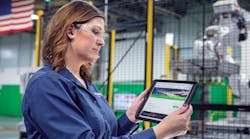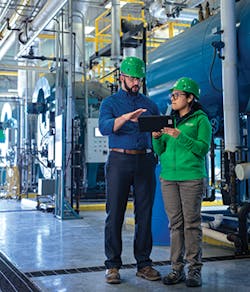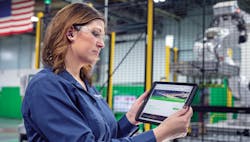The Schneider Electric facility in Lexington, KY, manufactures safety switches and load centers, but this smart factory also serves as a testing ground and flagship success story for the company’s own digital journey. At the 500,000-square-foot facility, its 400 employees produce about 16,500 finished goods and dozens of each type of products per day. With the help of technology and Schneider Electric’s vertically integrated process, humans do not touch those products as raw materials until the component assembly process. A long legacy of control systems and digital products make this factory smart, but its latest update with an open architecture platform for cloud and edge control has reduced system downtime by 5%.
This article is part of our monthly What Works column. Read more from our monthly What Works series.
While its newest technologies provided a two-year return on investment, and savings in energy efficiency and production, the digital journey for Schneider Electric actually began much earlier, about a decade ago. Through expansions that added Ethernet infrastructure and equipment connectivity, the Lexington plant laid the foundation long ago to welcome the industrial internet of things (IIoT) revolution and set the groundwork for becoming a smart facility.
All under one roof
“Over the years, we’ve moved from highly manual processes to more automated processes that require smarter control systems,” says Kenneth Labhart, innovation leader for supply chain in North America at Schneider Electric. “We are a discrete manufacturing facility, but we’re very fortunate enough to be heavily vertically integrated here at the facility.”
All of the processes and operations take place in that location, such as stamping sheet metal from raw coiled steel, stamping current carrying components, running plastic injection molding machines for the insulating components, painting the shaped metal enclosures, melting plastic pellets to make the interiors, stamping in the metal busbars, electro-plating busbars and finally, assembling the components into the final product.
“All those operations take place under one roof here in the facility, so we’ve been very fortunate in order to be able to control those processes for the product,” Labhart says. However, with so many different departments, they began to evolve at different rates in terms of how they stored, reported, and used operational data. Different goals and a lack of proper communication led to information that wasn’t helpful between departments or to see the bigger picture, as different departments stored historical data differently.
“We had a large performance problem across those departments in terms of reporting machine and process performance, and everybody had their own storage method. They had their own performance reporting method, and as a result what you wound up with was silos of data that were difficult to share,” Labhart says.
About four years ago, with the use of new technology the Lexington plant started to knock down some of those information silos and began to share tribal knowledge across the organization. “What’s at the heart of digital transformation is empowering the people with the right data to make the right decisions at the right time,” Labhart says.
To begin the digital transformation process, the department teams met to discuss problems the staff faced regularly. The biggest complaint across the board, Labhart says, was a lack of visibility with performance data and limitations on accessing data.
Another important building block for the smart factory was the early installation of a robust RFID system for product tracking and routing through an automated conveyor system. The components are eventually delivered to the assembly area, in the right order and priority for the assembly process. At the time, the new RFID system delivered huge production gains and enhanced the rich base of connected products and performance data. Originally, installed to eliminate material handling waste, the RFID implementation was the first step toward more precise edge control and using advanced software for data analytics.
From silos to cloud
To get, finally, to connecting machines with their important data, the Lexington plant turned to EcoStruxure, Schneider Electric’s open architecture platform (see Figure 1). The software includes many different tools, which the plant matched to fix specific problems that it was facing.
Figure 1. Schneider Electric’s facility in Lexington, KY, used its EcoStruxture product to better connect its automated processes and utilize important performance data.
Right from the start with some initial small-scale data analysis, the software program showed huge gains in productivity. With six data points from the plant’s automated conveyance system, provided by the RFID sensors, analysis gave supervisors and production managers real-time visibility into the process. “We were able to eliminate the downtime associated with that assembly process and increased the productivity by about 6% right there off the bat immediately, just by having that type of access to that data anywhere in the building or anywhere outside the building,” Labhart says.
Very quickly the engineers and maintenance staff saw what could be done with the data, and over the next 18 months, the performance analysis grew from six to 1,300 different data points throughout in the facility. “So that first small step showed everybody what it could do, and it was adopted rapidly,” Labhart says.
The factory has real-time data and alarms to monitor endless processes and equipment, such as temperatures from critical welding processes, equipment vibrations, and travel motor current. It has not only improved the overall process and productivity of the plant, but equipment maintenance was also improved with better access.
“Our processes have evolved with more and more automated equipment. With that automated equipment came complexity,” Labhart says. If problems arose, not only did the plant need highly skilled technicians, but it also needed them on-site to troubleshoot and diagnose. The platform’s Augmented Operator Advisor, which collects machine information for an augmented reality format, was installed on 16 pieces of equipment. The data is viewable from a standard portable tablet, and the tool provides information augmented over a real-time view of the machine, along with the latest set of schematics and documentation for technicians. “That was a major win for us there in those 16 pieces of equipment. We saw nearly a 20% reduction in mean time to repair,” Labhart says.
Filter technology helps odor issues at wastewater facility
How a rotary screw blower saved this plant $190,000 in energy savings
The platform includes a number of other software applications designed for different purposes, such as the power monitoring expert, which is an edge application that can pull power consumption data from the equipment and processes. “It gives you the visualization and descriptive analytic capability of the edge, to know exactly where you use your energy and how you used it,” Labhart says. The plant utilized this in the paint room with a series of connected meters that monitor the process’ energy consumption. With the EcoStruxure Resource Advisor app, which provides the analytics layer, engineers can visualize energy consumption at the edge and make adjustments in real-time to optimize energy consumption. This has allowed facility engineers to achieve energy savings year-over-year, as well as track future usage trends. Schneider Electric estimates that the energy program has produced $6 million in savings over the last several years.
The AVEVA Edge app (formerly AVEVA InduSoft Web Studio) is the software interface that compiles the data and reports and sends mobile notifications on the shop floor regarding machine performance. In the paint room, for example, the plant monitors 167 critical variables and collects historic information for performance analysis.
The foundation of connected devices and advanced edge control sets the stage for AVEVA Insight, the cloud-based software platform, which also provides descriptive data analytics and shares the dashboard data through mobile apps or signal alerts via push notifications.
Remote connectivity has been paramount during the pandemic. While the plant was already in part using mobile access, Labhart says the pandemic drove a higher adoption rate of the collaborative platforms (see Figure 2). It also provided another important benefit for ongoing projects with partners, like AVEVA. “We’ve been able to conduct proof of concepts using their applications on our edge layer and provided them with remote access to applications using EcoStruxure Secure Connect Advisor,” Labhart says. “So that’s been big for us when other companies were stopping those types of projects because in-person visits weren’t allowed. We were able to have those people work safely and effectively in a cyber secure manner, to access our edge applications and collaborate on the development of the analytics program.”
Figure 2. The company already had remote capabilities prior to the pandemic and it helped facilitate on-going projects with development partners.
The future: security and culture
Added digital technologies can present new cybersecurity challenges, which are also continually evolving. Labhart says the plant learned to bring information technology (IT) and operational technology (OT) professionals together early on in the process. “Those two groups of people cannot stay isolated,” Labhart says. Both groups need to work openly to discuss what is needed on the factory floor and the best fit for cybersecurity, as they often have different goals. “They have to collaborate with each other,” Labhart says.
Luke Durcan, director of EcoStruxure at Schneider Electric, brings clients to the Lexington facility often to see the product in action. “What a lot of our clients find is it’s difficult to know where to start,” Durcan says. “It’s difficult to know where you are on the journey and what investments you should make. And Lexington is a lighthouse for that purpose.” At Lexington, he can show other plant managers firsthand what works and what didn’t. “They understand that we suffer the same pain that they do because they’ve all got scars around digital transformation,” Durcan says.
In the end, though, it takes more than just good technology. Durcan also credits the culture at Schneider Electric as a big factor in its digital success. “Technology can be world-class outstanding, but if you don’t have the culture, the people, and the process to apply that technology, it’s dead in the water,” Durcan says. “That’s something I talk about with my client because we can sell them the technology; we can’t sell them a culture. We have to encourage them to think about that as part of their digital transformation strategy.”
The hybrid solution on the edge and in the cloud makes the best use of both platforms. “We’re convinced that in the future, you’re going to have on-prem computers that manage a lot of the devices or a lot of processes, and you’re going to have supervisory cloud capability that adds additional intelligence,” Durcan says. The next steps involve removing human intervention from processing intelligence with the data. Humans can be error-prone and they require time to perform tasks, and moving that intelligence execution to the hardware level should be the goal, Durcan says. In order for the plant system to automatically self-adjust to improve production, there needs to be as little as possible between the two layers, the on-prem computer and the cloud supervisory intelligence layer. “At the moment, we’ve got a lot in between. We’ve got a lot of clutter,” Durcan says. “The clutter is a function of our history and our evolution. At the moment, a lot of that clutter adds a lot of value, so you can’t rip it out.” The journey will continue.
At the Lexington facility, some of the next steps involve machine learning to improve critical welding processes. With the vast data, the plant has identified and can detect anomalies in the weld cable temperatures, in order to catch cable failures before they shut down a machine. “That’s been very powerful for us, so we’re just now beginning that journey where we evolve out of just merely having the data and visualizing the data. Now, we’re going to start using it more intelligently,” Labhart says.
This story originally appeared in the November 2021 issue of Plant Services. Subscribe to Plant Services here.




